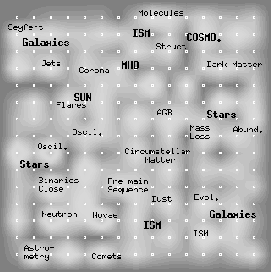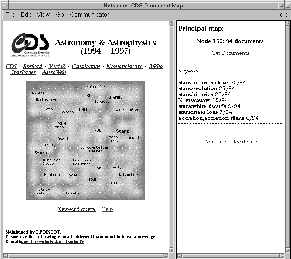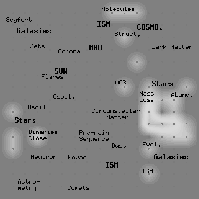Next: Knowledge Discovery in Literature Data Bases
Up: ``Robots Are Us'': Automated Information Discovery
Previous: Addressing the Heterogeneity of
Subject Indexing in the ADS Databases
Table of Contents -- Index -- PS reprint -- PDF reprint
Library and Information Services in Astronomy III
ASP Conference Series, Vol. 153, 1998
Editors: U. Grothkopf, H. Andernach, S. Stevens-Rayburn, and M. Gomez
Electronic Editor: H. E. Payne
Philippe Poinçot
Observatoire de Strasbourg, Université Louis Pasteur, Strasbourg,
France
Soizick Lesteven
Observatoire de Strasbourg, Université Louis Pasteur, Strasbourg,
France
Fionn Murtagh
Observatoire de Strasbourg, Université Louis Pasteur, Strasbourg,
France; Faculty of Informatics, University of Ulster, Londonderry,
Northern Ireland
Abstract:
We have developed and used the ``CDS document map'' based on neural
networks (Kohonen maps)
In this
self-organizing map, documents are gradually clustered by subject
themes. The tool is based on keywords associated with the documents. For
one selected document, we locate it on the CDS document map and retrieve
articles clustered in the same area.
The second search engine, used by the ADS![[*]](foot_motif.gif) , has the capability to find all
similar abstracts in the ADS database, with ``keyword request''.
, has the capability to find all
similar abstracts in the ADS database, with ``keyword request''.
We have compared the results of the document similarity search engines,
using the same set of documents. One example will be described
and results will be discussed.
Information broadcasting techniques are constantly in development.
This is the reason why electronic publications have become more and more
important in many domains, and particularly in astronomy.
It is possible to access many documents on-line, and it is important to
have efficient information retrieval tools at our disposal.
In this article, we will discuss the bibliographical information
retrieval system we have developed at the Centre de
Données astronomiques de Strasbourg (CDS).
In order to validate our system,
we compare our results with those from the ADS.
The initial results are then discussed.
We are developing, at the CDS, an information retrieval tool, based on
Self-Organizing Maps (SOM).
These maps are one of the artificial intelligence techniques, and more
precisely an unsupervised neural network.
A SOM can be considered as a table where objects are classified
(Figure 1). In such a table, similar objects are located in the
same area. In the example (Figure 1-right), a global
classification is shown: the three different shapes
are located in three different clusters, furthermore the largest objects
are located towards the center of the table, and each cluster is ordered:
the largest objects are at one side of a cluster, smaller shapes are at
the other side.
Now, let us see how a SOM works:
- each object is described by a vector. In the example, the vector
has two components: the first corresponds to the number of angles,
and the other to the width of the area.
- initially, a vector is randomly associated with each
box (or ``node'') of the table.
- each document is located in a box whose descriptive vector is the
most similar to the object's vector.
- during a cyclic learning process, the components of the nodes
describing vectors are modified. The learning process produces the
classification.
Figure 1:
Object locations. Left: before learning. Right: after
learning
 |
We have used the SOMs in order to classify some bibliographical data. In
this study, our set of documents comes from the journal ``Astronomy and
Astrophysics'', from 1994 to 1998. The descriptive vector is based on the
journal keywords associated with each document.
We eliminated the rare keywords (keywords found in less
than 5 documents).
Finally, we used about 4000 documents described by 269 keywords.
We used the SOMs, adapting them to our own
needs:
- Documents located at a map edge have neighbors at the other side of
the map. It is then possible to reconfigure the map without losing the
similarity of closely clustered documents (Figure 2-left).
- When there are many documents (more than 30) in a node of the map,
we create a new map with the documents attached to this node and the 8
nodes
around it. Such a map is called local map, or detailed map
(Figure 2-right). The first map is called the
principal map. We used a 15x15 table for the principal map, and 5x5 for
the detailed maps.
Figure 2:
Our use of SOM. Left: shifting the rows or the columns.
Right: two classification levels
 |
We display this classification with a density map, which represents
graphically the areas containing papers of similar content and the number
of documents in the areas. Then, the map is labeled to locate on it the
themes dealt with (Figure 3-left).
The user can select one node of the map (by clicking on the picture) to
obtain some information about the articles located in it (the number of
documents and the keywords describing them appear on the right side of
the interface) (Figure 3-right).
The user can also access the detailed map, and/or the
article content (title, authors, abstract) and all the facilities
provided by the CDS bibliographical service (including a link to ADS and
to the on-line full paper when available).
The user interface allows one to select and display on the map only a
part of the database. This is used with keyword queries (only the
documents containing selected keywords are shown), or with an external
list of documents (bibcode queries).
Figure 3:
Left: the principal map. Right: the user interface.
 |
 |
In order to validate our document retrieval tool, we have begun a study
based on the comparison of our system with the ADS system, taken as a
reference. The ADS provides wide query possibilities, so we have been
able to use exactly the same set of documents with the two systems.
Two different types of comparison have been done. We first use the
ADS with keyword query to validate more precisely our system. For the
second
type of comparison we use the ADS with full-text query to compare the two
systems with similar criteria for document retrieval.
- The bibliographic map is based on keywords only;
the ADS can
process a keyword search![[*]](foot_motif.gif) or a full-text analysis.
or a full-text analysis.
- The bibliographic map provides a graphical view of classified
documents;
the ADS returns a sorted list of documents, corresponding to
the user's query.
The method consists of selecting one document, called ``starting
document'', and retrieving similar documents (coming from the same
bibliographic database) using the two systems. Then, the different sets
of documents are compared by an expert of the field.
More precisely:
Figure 4:
Spreading of documents retrieved by the ADS. Left to
right: 20, 40 and 60 documents.
 |
 |
 |
In the following, as a starting document, we have used the article:
``Metallicities and carbon abundances of 5 red supergiants of the SMC
globular cluster NGC 330'' from Meliani, M. T. et al.
(1995A&A...300..349M). This article is described by the following
keywords: GALAXIES: ABUNDANCES, MAGELLANIC CLOUDS,
STAR CLUSTERS, GLOBULAR CLUSTERS: NGC 330 (SMC), STARS: ABUNDANCES.
The starting document is located in node 6 of the detailed map, and only
2 of the 8 surrounding nodes contain documents (nodes number 5 and 11).
Finally, the first CDS list contains 19 documents with scores as
shown in Table 1.
For the keyword query, the ADS retrieved 323 documents. The 315 last ones
have the same small score because they are described only by one keyword
of the query. We eliminated them for our study. 17 documents remain,
only one is scored as less relevant by the specialist.
- 11 relevant documents are simultaneously retrieved by both systems.
- The bibliographic map retrieves 3 documents scored as relevant
that the ADS does not retrieve, but it misses 5 others. Three of
these documents are located in the Interstellar Medium (ISM) zone, and can be
retrieved by a keyword query with the bibliographic
map, using the keywords describing the starting document. The
two others are located in another node of the detailed map.
- The ADS retrieves 5 relevant documents (scored as relevant by the
expert) that the CDS does not retrieve, but misses 3 other relevant
documents. One of them is only described by one keyword of the starting
document, the two others are described
by another set of keywords (NASA-STI).
These initial results show that both systems retrieve almost the same
documents. They allow our system to be validated.
Table 1:
Results for the documents coming from the detailed map
(list 1).
| node |
relevant documents |
less relevant documents |
| 6* |
8 |
1 |
| 5 |
4 |
|
| 11 |
2 |
4 |
*node containing the starting document.
We take into consideration all documents of the detailed map, which
contains 80 documents (list-2); a check by an expert shows that 22 of
them are relevant, 58 are less relevant.
To compare the second ADS list (list B) with the map, we selected the
first 80 documents (the ADS sorts the documents by decreasing similarity
order). As we have seen in section 2.2.3., we can visualize on the
density map an external list of documents
when they are already classified on the map. In Figure 4,
we can see the location of the documents retrieved by the
ADS on the map, corresponding to the given starting document. There
is a spreading
of the documents while the list becomes
longer and longer. This means that the smaller a document's score is,
the farther away it will be located from the ``starting document''.
A check by an expert gives 25 relevant documents, and 55 less
relevant.
- 15 relevant documents are simultaneously retrieved by both systems
(Table 2).
- The bibliographic map misses 10 other relevant documents. These
documents may be lost because associated descriptive keywords are wrong
(typographic error), or not accurate enough: relevant or less relevant
articles are found to be described by
the same set of keywords. Other lost documents may be retrieved with a
keyword query (using the keywords describing the ``starting document''),
which shows articles in the ISM region for example.
- The ADS retrieves 10 relevant documents that the map does not
retrieve, but it misses 7 other relevant documents. There are 7 relevant
documents in the 20 first retrieved documents, 14 relevant documents
among the 20 subsequent retrieved documents,
and 25 in the whole set (list B).
The ADS missing relevant documents are retrieved if we examine the ADS
result list beyond the first 80 retrieved documents.
These results show that the list of documents retrieved by the ADS (the
first documents of the list B) is noisier. But if we examine the complete
list, the ADS retrieves more relevant documents than our system.
Full text analysis allows to retrieve more relevant documents, but
these are drowned in a longer set of documents.
Table 2:
Results for all the documents coming from the detailed
map (list 2), compared to the ADS (list B).
| |
relevant |
less relevant |
| ADS (first 80 documents) |
25 |
55 |
| map |
22 |
58 |
| common |
15 |
22 |
This study shows that the bibliographic map gives results comparable
with the ADS request by keywords. These first results allow us to
validate our information retrieval system.
When we compare our results to the ADS full text, we show that the
ADS retrieves more relevant documents, but it seems that the
bibliographic map is more accurate for the first retrieved documents. Is
seems logical that the full text search is noisier,
but more complete if full results are taken into account.
The two systems appear to be complementary, because about 60%
of the retrieved documents are identical, and both systems pull in other
similar documents. It is recommended to use both systems to get as
much relevant information as possible.
Furthermore the bibliographic map, with its graphical interface, is a new
approach which is well-designed for the Web. The keyword and bibcode
queries give some complementary access to the map. The links
existing between two neighboring nodes provide
a new mechanism for helping users retrieve similar documents.
But the bibliographic map works only with documents described by a
well-defined set of keywords. To extend this tool, we are going to develop a
new map based on full text analysis.
Further Reading
Honkela, T., Pulkki, V., & Kohonen, T. 1995, ICANN-95, 2, 3-7,
Kohonen, T. 1995, Self-Organizing Maps, (Berlin: Springer)
Lesteven, S., Poinçot, P., & Murtagh, F. 1996, Vistas in
Astronomy, 40(3), 395-400
Lin, X., Soergel, D., & Marchionini, G. 1991, In: Proc. 14th.
Ann. Int. ACM/SIGIR Conf. on R & D in Information Retrieval, 262-269
Murtagh, F. & Hernández-Pajarez, M. 1995, Journal of
Classification, 12, 165-190
Poinçot, P. 1997, Actes des Conférences INFORSID,
625-641,
Poinçot, P., Lesteven, S., & Murtagh, F. 1998, A&AS, 130, 183
Salton, G. 1991, Science, 253, 974
Footnotes
- ...ADS
- NASA Astrophysics Data
System
(http://cdsads.u-strasbg.fr
, http://adswww.harvard.edu
,
http://ads.nao.ac.jp
)
- ...search
- This is an old version of the ADS
Abstract Service, but still accessible.
© Copyright 1998 Astronomical Society of the Pacific, 390 Ashton Avenue, San Francisco, California 94112, USA
Next: Knowledge Discovery in Literature Data Bases
Up: ``Robots Are Us'': Automated Information Discovery
Previous: Addressing the Heterogeneity of
Subject Indexing in the ADS Databases
Table of Contents -- Index -- PS reprint -- PDF reprint
![[*]](foot_motif.gif) , has the capability to find all
similar abstracts in the ADS database, with ``keyword request''.
, has the capability to find all
similar abstracts in the ADS database, with ``keyword request''.
![[*]](foot_motif.gif) , has the capability to find all
similar abstracts in the ADS database, with ``keyword request''.
, has the capability to find all
similar abstracts in the ADS database, with ``keyword request''.
![[*]](foot_motif.gif) or a full-text analysis.
or a full-text analysis.